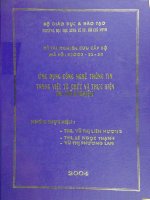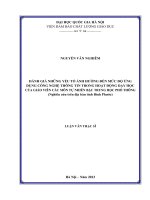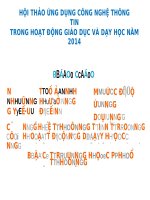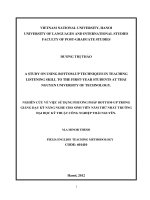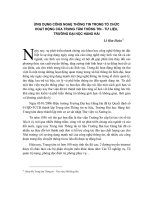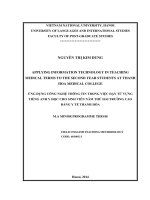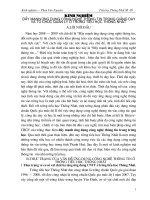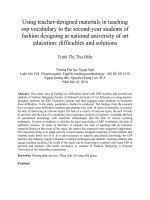Applying Information Technology In Teaching Medical Terms To The Second Year Students At Thanh Hoa Medical College = Ứng dụng công nghệ thông tin trong việc dạy
Bạn đang xem bản rút gọn của tài liệu. Xem và tải ngay bản đầy đủ của tài liệu tại đây (712.8 KB, 68 trang )
VIETNAM NATIONAL UNIVERSITY, HANOI
UNIVERSITY OF LANGUAGES AND INTERNATIONAL STUDIES
FACULTY OF POST-GRADUATE STUDIES
*************************
NGUYỄN THỊ KIM DUNG
APPLYING INFORMATION TECHNOLOGY IN TEACHING
MEDICAL TERMS TO THE SECOND YEAR STUDENTS AT THANH
HOA MEDICAL COLLEGE
ỨNG DỤNG CÔNG NGHỆ THÔNG TIN TRONG VIỆC DẠY TỪ VỰNG
TIẾNG ANH Y HỌC CHO SINH VIÊN NĂM THỨ HAI TRƯỜNG CAO
ĐẲNG Y TẾ THANH HÓA
M.A MINOR PROGRAMME THESIS
FIELD: ENGLISH TEACHING METHODOLOGY
CODE: 60140111
Hanoi, 2014
VIETNAM NATIONAL UNIVERSITY, HANOI
UNIVERSITY OF LANGUAGES AND INTERNATIONAL STUDIES
FACULTY OF POST-GRADUATE STUDIES
*************************
NGUYỄN THỊ KIM DUNG
APPLYING INFORMATION TECHNOLOGY IN TEACHING
MEDICAL TERMS TO THE SECOND YEAR STUDENTS AT THANH
HOA MEDICAL COLLEGE
ỨNG DỤNG CÔNG NGHỆ THÔNG TIN TRONG VIỆC DẠY TỪ VỰNG
TIẾNG ANH Y HỌC CHO SINH VIÊN NĂM THỨ HAI TRƯỜNG CAO
ĐẲNG Y TẾ THANH HÓA
M.A MINOR PROGRAMME THESIS
FIELD: ENGLISH TEACHING METHODOLOGY
CODE: 60140111
SUPERVISOR: Dr. DƯƠNG THỊ NỤ
Hanoi, 2014
i
DECLARATION
I certify that the thesis entitled "Applying information technology in
teaching medical terms to the second year students at Thanh Hoa Medical
College" is the result of my own work. Thesis submitted in fulfillment of the
requirement for the award of the degree of Master in English Teaching
Methodology by Nguyen Thi Kim Dung.
August 2014
Nguyễn Thị Kim Dung
ii
ACKNOWLEDGEMENTS
I would like to express my deep gratitude to my supervisor, Dr. Dương Thị
Nụ for accepting me as her M.A. student so that I had the opportunity to study and
finish this thesis. She taught me how to do research through creative and critical
thinking, hard work and perseverance. I am grateful to her for her encouragements,
supports, valuable suggestion, guidance and patience.
I also would like to thank Dr. Lê Văn Canh for his valuable comments on my
work.
A big thank you goes to my colleagues. Especially, the teachers of English
from Foreign Language Division at Thanh Hoa Medical College, they are always
willing to spend time and share with me their knowledge and experience about
teaching English to help me with the research data.
Additionally, I have a special gratitude to my 200 students of Thanh Hoa
Medical College for their willing to support and provide thoughtful responses to the
survey questions.
Last, this work could not have been finished without the unlimited support
and continuous encouragement of my family in every stage of this study.
iii
ABSTRACT
Applying IT in general and MS PowerPoint in particular to teaching and
learning English is a motivation for innovation process of the teaching method with
the aim to highlight an efficiency of teaching and learning. The propose of this work
was to identify the challenges of application MS PowerPoint in teaching and
learning to find out possible solutions to the found difficulties in order to help
teachers enhance the quality of EMP vocabulary teaching at Thanh Hoa Medical
College. The data were collected by means of questionnaires and interviews. The
results showed that both teachers and students have positive attitude toward
application of PowerPoint in EMP vocabulary teaching and learning process. The
findings examined that students at TMC strongly advocated the importance and
necessity of applying PowerPoint in EMP classes. They were more comfortable and
motivated in EMP lessons with the support of PowerPoint. The interviews were
developed so that the researcher can get deeper information to understand and
clarify some issues related this application. Teachers perceived MS PowerPoint as
the essential tool for teaching EMP terms that are considered as difficult for
students to memorize. The survey results highlight the positive effect and necessity
of using PowerPoint in teaching EMP vocabulary to improve students' Medical
terms competence. In addition, this work will hopefully be a reliable source of
reference for teachers of English in general to develop teaching methods and
PowerPoint application in class.
iv
LIST OF TABLES AND CHARTS
Tables
Table 1: Students’ experience in learning English
Table 2: The purposes of learning EMP vocabulary
Table 3: The advantages of using PowerPoint in learning EMP vocabulary
Table 4: Teachers’ teaching experience
Table 5: Teachers' techniques of teaching EMP vocabulary
Table 6: Teachers’ opinions of the benefits of applying PowerPoint in ELT
Table 7: Teachers’ confidence in using PowerPoint in teaching
Table 8: Teachers’ challenges in using PowerPoint
Charts
Chart 1: Students' interest towards learning EMP vocabulary
Chart 2: The frequency of using PowerPoint designed by teachers
Chart 3: Students’ attitude toward the importance of EMP vocabulary
Chart 4: Students’ assessment on the effectiveness of PowerPoint
Chart 5: Teachers' attitude toward the importance of using PowerPoint in teaching
EMP vocabulary
Chart 6: Teachers’ assessment on the effectiveness of PowerPoint
v
LIST OF ABBREVIATIONS
AECT: Association for Educational Communication and Technology
CALL: Computer Assisted Language Learning
IT: Information technology
ELT: English Language Teaching
ESP: English for Specific Purposes
ESL: English As Second Language
EFL: English As Foreign Language
EGP: English for General Purpose
ESP: English for Specific Purposes
EMP: English for Medical Purpose
TMC: Thanhhoa Medical College
vi
TABLE OF CONTENTS
DECLARATION i
ACKNOWLEDGEMENTS ii
ABSTRACT iii
TABLE OF CONTENTS vi
LIST OF TABLES AND CHARTS iv
LIST OF ABBREVIATIONS v
TABLE OF CONTENTS vi
PART A: INTRODUCTION 1
1. Rationale 1
2. Objectives of the study 2
3. Research Questions 2
4. Research Methodology 2
5. Scope of the study 2
6. Significance of the study 3
7. Design of the study 3
PART B: DEVELOPMENT 4
CHAPTER 1: LITERATURE REVIEW 4
1.1. Definition of vocabulary 4
1.1.1. The importance of vocabulary in language teaching and learning 4
1.2. English for specific purposes (ESP) 5
1.2.1. Definition of ESP 5
1.2.2. Medical English 6
1.2.3. The roots of medical terminology 7
1.2.4. Teaching and learning ESP vocabulary 8
1.3.2. Information Technology in English Language Teaching 9
1.3.3. Computer-Assisted Language Learning (CALL) 11
1.3.4. Role of Information Technology in language teaching 13
1.3.5. Technological resources currently deployed in language teaching 15
1.3.6. The difficulties in applying MS PowerPoint in EFT 18
CHAPTER 2: METHODOLOGY 19
2.1. The survey research 19
2.2. Context of the study 20
2.3. Participants 20
vii
2.4. Instrument 21
2.4.1. Interviews 21
2.4.2. Questionnaires 22
2.5. Procedures of data collection 22
CHAPTER 3: DATA ANALYSIS AND DISCUSSION 23
3.1. The students‟ questionnaire 23
3.1.1. Students' opinions about using PowerPoint in learning EMP vocabulary 23
3.1.2. Students‟ assessment on the effectiveness of PowerPoint (PP) 27
3.2. The teachers' interview questions 28
3.2.1. The benefits of applying IT in teaching EMP vocabulary 28
3.2.2. Teachers‟ challenges in using PowerPoint in teaching EMP vocabulary 34
3.2.3. Teachers‟ suggested solutions 36
PART C: CONCLUSION 38
1. Major findings of the study 38
2. Conclusion 39
3. Limitations of the study 40
4. Suggestion for further studies 41
REFERENCES 42
APPENDICES I
APPENDIX 1 I
APPENDIX 2 V
1
PART A: INTRODUCTION
1. Rationale
Information technology is a major force that has brought about revolutionary
changes in the development of the global, digital society. Education is considered
the foundation for development and the concept of IT use in education as powerful
tools is strongly encouraged in Vietnam. Applying IT to teaching and learning is
also one of the essential tasks of the National Education Service at present. Like
other subjects, applying IT to teaching and learning English is a motivation for
innovation process of the teaching method with the aim to highlight an efficiency of
teaching and learning. English is a communicative subject so teachers always have
to prepare teaching aids for their lessons. Without teaching aids such as pictures,
posters, real things and so on, English lessons are very boring and unattractive.
Applying IT to teaching English not only helps teachers save their time but also
makes learners access to their lessons easier. However, applying IT in teaching is
still a challenging new task. English teachers at Thanh Hoa Medical College have
coped with the challenges of technological and pedagogical shifts occurring in the
teaching profession, especially in teaching and learning ESP vocabulary. ESP is
viewed as something hard to teach for language teachers. As a teacher of English
for Medical Purposes, I find it difficult to understand a lot of terminology,
complicated words and how to enhance students' learning interest for each lesson. It
seems challenges for teachers to consider suitable methods to teach learners. Facing
this problem, the teachers of English of Thanh Hoa Medical College want to do
something to change the ways of teaching vocabulary in order to improve the
students' learning effectiveness to help them succeed in their future job by using
Microsoft (MS) PowerPoint. It is the active display software. We can use it to make
lesson plans and teach vocabulary, grammar, listening, speaking, reading and
writing skills In this report, we only discuss applying MS PowerPoint to teach
EMP vocabulary. With the support of PowerPoint, teachers not only save time, but
also help students understand meaning of new words more easily. Lessons with
2
lively pictures, sound, video, etc become more interesting, more attractive and
students have a chance to speak English more. Therefore, I have conducted a
research to find out the main difficulties in applying MS PowerPoint of teachers at
Thanh Hoa Medical College, then to offer some solutions to these problems.
2. Objectives of the study
The objectives of the study are as follows:
To investigate the challenges the teachers encounter in applying IT (MS
PowerPoint) in teaching medical vocabulary to the second year students at TMC.
To provide suggestions to enhance effective utilization of MS PowerPoint in
teaching medical vocabulary at the college.
3. Research Questions
From our research objectives set, we are able to formulate the following
research questions:
Question 1: What do teachers in Thanh Hoa Medical College think of the benefits
of applying MS PowerPoint in English language teaching?
Question 2: What challenges do they encounter in applying MS PowerPoint in
teaching English Medical vocabulary at TMC?
Question 3: What are their suggested solutions to get more effectiveness in applying
MS PowerPoint in teaching English at the college?
4. Research Methodology
To answer the research questions, we chose a survey research to explore the
reality and the impact of the teacher‟s application of MS PowerPoint on students'
learning ESP vocabulary. People who take part in this research are 10 ESP teachers,
200 the second year students (non-English majors) who are learning ESP at Thanh
Hoa Medical College.
5. Scope of the study
This research only focuses on the application of some popular, suitable and
easy-to-use MS PowerPoint in teaching Medical vocabulary to the second year non-
English major students at Thanh Hoa Medical College. The results of this study will
3
be used to deepen my understanding of how to use MS PowerPoint to improve ESP
vocabulary teaching at the college.
6. Significance of the study
The result of the study illustrates theory of teaching English language with
the support of MS PowerPoint. This research does not only provide a deep insight
into the effectiveness of applying MS PowerPoint to the teaching ESP vocabulary to
second-year English non-majors but also contributes in ESP teaching method
innovation. The researcher found out possible solutions to the found difficulties in
order to help teachers enhance the quality of EMP vocabulary teaching. This
research helps students to enhance their participation in EMP vocabulary lessons
that is considered as difficult to learn.
7. Design of the study
This thesis is composed of the following three main parts:
Part A, INTRODUCTION, presents the rationale of the study, the objectives, the
research questions, scope, significance, methods, and the design of the study.
Part B, DEVELOPMENT, consists of three chapters:
Chapter 1, LITERATURE REVIEW, deals with the literature focusing on the
theoretical basis related to teaching vocabulary and applying IT in language
learning and teaching.
Chapter 2, METHODOLOGY, details a survey research as the method of the study,
the participants and the instruments to collect data.
Chapter 3, DATA ANALYSIS AND DISCUSSIONS, presents the results of the
study and data analysis, the findings in which research questions are revealed and
discussed.
Part C, CONCLUSION, summarizes the major findings and gives conclusions.
Limitation and suggestion for further study are also discussed in this chapter.
4
PART B: DEVELOPMENT
CHAPTER 1: LITERATURE REVIEW
This chapter presents an overview of the literature in which key concepts,
theories in the field. There are three main parts: An overview of vocabulary;
English for specific purposes; Information Technology.
1.1. Definition of vocabulary
The term "vocabulary" appears to be a very simple concept but in fact, we
can find it extremely difficult to give an exact definition of vocabulary. Based on
different criteria, linguistics defined vocabulary in different ways. According to Ur,
(1996:60) vocabulary is defined "as the words we teach in the foreign language.
However, a new item of vocabulary may be more than a single word: a compound
of two or three words or multi- word idioms". Pyles and Algeo (1970: 96) also
noted that "It is in words that sound and meanings inter-lock to allow us to
communicate with one another and it is words that we range together to make
sentences, conversations, and discourses of all kinds"
Therefore, the teaching of vocabulary to foreign language learners has long
been an area of concern to language teachers because learning vocabulary in a
foreign language is much more than making form - meaning correspondences and
simply filling up individual words “Knowing a word, according to Nation (2001)
means knowing at least its forms, its meanings and its basic usage”
1.1.1. The importance of vocabulary in language teaching and learning
Words are the building blocks in a language. By learning the lexical items,
we start to develop knowledge of the target language. Based on our experience of
being a language learner, we seem to have no hesitation in recognizing the
importance of vocabulary in L2 learning. Meare (1980) points out that language
learner admit that they encounter considerable difficulty with vocabulary even when
the upgrade from an initial stage of acquiring a second language to a much more
advanced level. Language practitioners also have reached a high degree of
consensus regarding the importance of vocabulary. The findings in Macaro‟s survey
5
(2003) indicate that secondary language teachers view vocabulary as a topic they
most need research to shed light on to enhance the teaching and learning in their
classrooms. In fact, vocabulary always holds a significant place in foreign language
teaching and learning. According to Troike (1976: 87), “Vocabulary is most
important for understanding and knowing names for things, actions and concepts”
Also, vocabulary knowledge can help language users perform and develop language
skills since “substantial vocabulary knowledge is always a prerequisite to the
performance of language skills. Vocabulary enables language use, language use
enables the increase of vocabulary knowledge and language use and so on” (Nation
and Waring, 2004: 6-19). Therefore, it is undeniable that vocabulary plays an
extremely important role in making a success of language learning and that the
acquisition of adequate vocabulary is essential for successful second language use.
Vocabulary is the tool of thought, self-expression, translation and
communication. In any language teaching, vocabulary plays a tremendously
important role. The famous linguist Wilkins said people could describe few things
without grammar, but they could express nothing without vocabulary. Widdowson
thought that the native English speaker can understand those language material with
correct vocabulary but not so proper in grammar rules rather than those with correct
grammar rules but not so proper in vocabulary use. Lewis (1993) held the idea that
vocabulary acquisition is the main task of Second Language Acquisition and the
language skills as listening, speaking, reading, writing and translating all cannot go
without vocabulary. Non-native language learners usually tend to make mistakes
about vocabulary; the most difficult thing in listening is vocabulary. Foreign
language teaching methods are various but all show the importance of vocabulary
teaching. To start learning a foreign language is connected with learning the words.
1.2. English for specific purposes (ESP)
1.2.1. Definition of ESP
ESP is developing gradually between countries with the enlargement and
development of science, technology, economy etc. Meanwhile, many countries
6
advocate their citizens to master English that regarded as the international language
in the fields of science and business trade, to get rid of the puzzledom brought by
the war, to revitalize economy and to develop science and technology. In the late
period of the 60s of 20th century, several linguists like Halliday, Macintosh,
Strevens (1964) and Hutchinson & Waters (1987) illustrated the concept of ESP.
Halliday, Macintosh, Strevens believe that: English is for civil servants; for
policemen; for officials of the law; for dispensers and nurses; for specialists in
agriculture; for engineers and fitters.
According to Hutchinson and Waters, (1987, p.19), ESP is “an approach to
language teaching in which all decisions as to content and method are based on the
learner‟s reason for learning”. Likewise, Strevens (1988:1) said, “ESP is a particular
case of the general category of special-purpose language teaching”
1.2.2. Medical English
English for Medical Purposes (EMP) is one of the genres in English for
Specific Purposes (ESP). Class subjects in ESP have been getting widespread among
Japanese university. ESP has been trying to attain its popularity since the 1990s
among Japanese university in the growing necessities in ESP genres such as English
for economics, business, English for law, and English for Science and Technology
(EST), judging from the JACET annual conferences for the past two decades.
However, class subjects in EMP are still small in number in Japan compared
to other ESP genres despite the strong need of EMP, judging from the proceedings of
JACET annual conferences in 2008 and 2009. In fact, medical students and nursing
students have various reasons for learning medical English (Kawagoe, 2009). They
English for Specific Purposes (ESP)
English for Business and
Economics (EBE)
English for
Scientific Study
(EST)
English for
Social Study
(ESS)
English for Academic Purposes & English for Professional Purposes (EAP & EPP)
7
need to read journals and books in medical genres. Doctors and nurses also need to
read journals and books and to speak to colleagues on professional visits, to make use
of the expanding and increasingly important database available through the internet,
to participate in international conferences, to write up research for journal
publication, to take postgraduate courses in the U.S. or in U.K to work in hospitals
where English is the first language or the lingua franca.
1.2.3. The roots of medical terminology
Medical terminology is the special vocabulary developed over time for use by
physicians to “accurately describe the human body and associated components, conditions,
processes and procedures in a science-based manner”. Medical terminology has also
been defined as “the science which deals with the investigation, arrangement and
construction of medical terms”. It is this second definition that has developed the
corpus described in the first definition, the roots of which can be found in the
historical records of medical history. Although the history of medicine is quite long,
virtually as long as human history itself, modern medical terminology rests primarily
upon a Greek and Roman foundation. Indeed, early Greek physicians certainly
learned and accumulated a great deal of medical knowledge from other civilizations,
especially from ancient Egypt and India, but it was the Greeks who assimilated this
knowledge and gave it names that spread to other lands, e.g. throughout the Roman
Empire, that gave its use force and weight. This subsequent mixture of Greek and
Latin medical terms and word formation is the basis for many of the currently used
medical terms used today by medical professionals. For example, the word “diabetes”
was derived from the Greek word meaning “a siphon” the 2nd - century A.D. Greek
physician, Aretus the Cappadocia, named this condition “diabetes” after he observed
that patients with this problem “passed water like a siphon”. However, many more
medical words are often cobbled together from two or more building blocks, also
derived mainly from Greek or Latin origins, along with many prefixes and suffixes
that form the components of many polysyllabic medical terms.
8
1.2.4. Teaching and learning ESP vocabulary
Teaching English vocabulary is an important area worthy of effort and investigation.
Recently methodologists and linguists emphasize and recommend teaching vocabulary
because of its importance in language teaching. As mentioned earlier, ESP is an
approach to language teaching, which is “directed by specific and apparent reasons for
learning”. Thus, whether it is labeled as „learner-centered‟ or „learning-centered‟, the
focus of ESP teaching, in light of the global Communicative Language Teaching, is
both on the learner and the process of learning in the context it takes place. Since
emphasis is laid on the learner and the learning process, in discussing ESP teaching, a
number of factors must be taken into consideration such as motivation, learning
strategies, theories of learning, etc. In addition, sufficient attention should be paid to
issues closely related to any language course such as syllabus design, material
development, methodology, assessment and evaluation. Through the history of
language teaching there are many teaching theories and methods appearing at different
time. As Carter and McCarthy (1988) commented that the history and development of
vocabulary teaching is more a series of dominating ideologies or fashions that have
succeeded one another. Teachers must keep in mind that there are no perfect and
exclusive methods in language teaching, therefore, the application of a suitable
approach needs supplementation of other approaches in vocabulary teaching. Nation
(1990) declared that there is a wide variety of ways for dealing with vocabulary in
foreign language learning. it is important that when a teacher chooses or rejects a way
to deal with vocabulary, this choice or rejection should be based on a good
understanding of the way of dealing with vocabulary such as the principles behind it,
and its theoretical and experimental justification. Besides, learners‟ need is another
important factor, which language teachers have to consider when they choose their
teaching methods. For this reason, an attempt is made to bring about a glimpse of a
prominent issue in ESP teaching.
9
1.3. Information Technology
1.3.1. Definition of Information Technology
According to the Information Technology Association of America, Information
Technology (commonly called simply IT) can be defined as “the study, design,
development, implementation, support or management of computer-based information
systems, particularly software applications and computer hardware”. Encompassing the
computer and information systems industries, information technology is the capability
to electronically input, process, store, output, transmit, and receive data and
information, including text, graphics, sound, and video, as well as the ability to
control machines of all kinds electronically. It refers to anything related to
computing technology, such as networking, hardware, software, the Internet, or the
people that work with these technologies. In Vietnam, the concept of Information in
the Resolution 49/CP signed on April 8, 1993 on the development of information
technology by the Government of Vietnam. IT is understood and defined,
“Information technology is collection of scientific methods, the means, and tools of
modern technology-mostly computer engineering and telecommunications -to organize
the exploitation and use effectively the resources are rich information and potential
in all areas of human activity and society” (Resolution 49/CP, 1993).
1.3.2. Information Technology in English Language Teaching
IT has a deep influence on the development of all the fields in our modern
life. With the development of era, the application of IT to teaching is one of the
essential tasks. The application of IT to teaching and learning has been affirmed by
the Party: “We should improve teaching methods, change the teaching and learning
in one way, make learners more positive and more creative during the lessons and
step by step apply the best and advanced methods to teaching and learning”
IT is considered as an effective tool to innovate the way of teaching, learning
and management, contributing to enhance the efficiency and quality of the education.
In teaching history, we can use IT to do tasks as follow: to access information sources
(internet, CD ROMs), to save historical document (texts, images, sounds, documentary
10
films ), to integrate listening and viewing functions of the teaching aids used to
teach history in the past years; to design slide shows for the scientific seminars, to
make electronic lesson plans and to organize picnics or outdoor activities and so on.
There are many ways to define the term Educational Technology. Everyone
agrees that it is undeniable that new information technologies are the most notable
and visible of “globalization” into school space. Some other educators use this term
to refer to any things that teachers can use in teaching, such as media images, audio
or digital devices or “refer to the application of computer or electronic equipment in
the teaching and learning” (Muffoletto, 1994:99). The most general one, used by the
Association for Education Communications and Technology (AECT), “Educational
Technology is the study and ethical practice of facilitating learning, and improving
performance by creating, using, and managing appropriate technological processes
and resources”. In this definition, we can include a wide array of technology
including computers, software, slides, photographs, e-mails, CD-ROMs or DVD-
ROMs, the Internet, videotapes, and instructional television.
In this the term “technology” is used in a very narrow sense. In fact,
„technology‟ in this study refers to the use of the PowerPoint as a support to
teaching ESP vocabulary. According Kisito, PowerPoint presentations consist of a
number of individual pages or "slides". The "slide" analogy is a reference to the
slide projector. Slides may contain text, graphics, sound, movies, and other objects,
which may be arranged freely. Most PowerPoint presentations are created from a
template, which includes a background color or image, a standard font, and a choice
of several slide layouts. PowerPoint, however, facilitates the use of a consistent
style in a presentation using a template or "Slide Master". Kisito, F (2007:1-2). We
can also apply Microsoft PowerPoint to designing diagrams, sketches and maps
with mutable images in order to illustrate lessons. With the support of Microsoft
PowerPoint learners feel easy to understand their lessons and they are more active
and more positive during the lessons.
11
1.3.3. Computer-Assisted Language Learning (CALL)
The term most widely used when it comes to the application of information
technology in language teaching is CALL. "CALL" is not a method. CALL materials are
tools for learning. The focus of CALL is learning, and not teaching. CALL
materials are used in teaching to facilitate the language learning process. It is a
student-centered learning material, which promotes self-paced learning.
CALL is often perceived, somewhat narrowly, as an approach to language
teaching and learning in which the computer is used as an aid to the presentation,
reinforcement and assessment of material to be learned, usually including a
substantial interactive element. Levy (1997:1) defines CALL more succinctly and
more broadly as "the search for and study of applications of the computer in
language teaching and learning"
CALL's origins and development trace back to the 1960s (Delcloque 2000).
Since the early days CLL has developed into a symbiotic relationship between the
development of technology and pedagogy. In the late 1970s, the arrival of the
personal computer (PC) brought computing within the range of a wider audience,
resulting in a boom in the development of CALL programs and a flurry of
publications. Throughout the 1980s, CALL widened its scope, embracing the
communicative approach and a range of new technologies.
Although CALL has gradually developed over 30 years, Warschauer divided
the development of CALL into three phrases: Behavioristic; Communicative;
Integrative (Multimedia and the Internet) (Baron & Debski, 1996). He said the
introduction of a new phase does not necessarily entail rejecting the programs and
methods of a previous phase; rather the old is subsumed within the new. In addition,
the phases do not gain prominence one fell swoop, but, like all innovations, gain
acceptance slowly and unevenly.
Behavioristic CALL: the first phase of CALL, conceived in the 1950s and
implemented in the 1960s and 70's, was based on the then-dominant behaviorist
theories of learning. Programs of this phase entailed repetitive language drills and
12
can be referred to as "drill and practice". Drill and practice courseware is based on
the model of computer as tutor (Taylor, 1980). In other words, the computer serves
as a vehicle for delivering instructional materials to the student. The rationale
behind drill and practice was not very spurious, which explains in part the fact that
CALL drills are still used today. In the late 1970s and early 1980s, behavioristic
CALL was undermined by two important factors. First, behavioristic approaches to
language learning had been rejected at both the theoretical and the pedagogical
level. Secondly, the introduction of the microcomputer allowed a whole new range
of possibilities. The stage was set for a new phase of CALL.
Communicative CALL: the second phase of CALL was based on the
communicative that became prominent in the late 1970s and 80s. In the
communicative approach, the focus is on using the language rather than analysis of
the language, teaching grammar implicitly and focuses more on using forms rather
than on the forms themselves. One of the main advocates of this new approach was
John Underwood, who in 1984 proposed a series of "Premises for 'Communicative'
CALL" (Underwood 1984:52). The communicative CALL programmes provide skill
practice in a non-drill format, through language games, reading and text
reconstruction. This approach still uses the computer as a tutor, although it gives
students choices, control and interaction. Another CALL model used for
communicative activities involves the computer as stimulus, as in programmes that
stimulate writing or discussions, and which may not be specifically designed for
language learners. Finally, communicative CALL also uses the computer as a tool,
in programmes that do not provide language material, but enable the learner to
understand and use the language, such as word processors, desk–top publishing,
spelling and grammar checks programmes, as used for instance in process writing.
Integrative CALL: integrative approaches to CALL are based two important
technological developments of the last decade- multimedia computers and the
Internet Multimedia technology allows a variety of media (text, graphics, sound,
animation, and video) to be accessible on a single machine. These resources are all
13
linked and called „hypermedia‟, enabling learners to navigate through CD-ROMS
and the Internet at their own pace and path, using a variety of media. Hypermedia
provides a number of advantages for language learning as followed:
creating a more authentic learning environment.
assisting the integrations of different skills.
offering students greater control over their learning.
facilitating a principle focus on the content, without sacrificing a secondary
focus on language form for learning strategies.
Three phases of CALL suggest that the computer can be used for a variety of
purposes in language teaching. It can be a tutor for language drills or skill practice,
a stimulus for discussion and interaction; or a tool for teaching and a medium of “global
communication and a source of limitless authentic materials” (Warschauer, M: 1996).
1.3.4. Role of Information Technology in language teaching
It is well known that our new life is highly affected by the era of IT, and
technology plays an important role in today‟s human society development. Based
on this fact, it is indispensable to take advantage of the modern technological
facilities in aiding the task of English language education. Students trying to learn
English as second language need further language support. They need to practice in
hearing language, reading language, speaking language, and writing language in
order to develop their experience and skills (Ybarra & Green, 2003). For doing such
tasks, they are in need of using various tools that can help them learn the language
easily and effectively.
In language teaching and learning, we have a lot of choose from the world
of technology: Radio, TV, Computers, the Internet, Electronic Dictionary, Email,
Blogs, Power Point, Videos etc. This rapid rising and development of IT has offered
a better pattern to explore the new teaching model. Using multimedia to create a
context to teach English has its unique advantages. Technology, when used
appropriately, can help the English and language classroom a site of active learning
and critical thinking. Teachers can adopt technology resources to develop and tailor
14
instructional materials to better meet individual student needs. Psychologist
Skinner, in the early 1960s stated that “I was soon saying that, with the help of
teaching machines and programmed instruction, students could learn twice as much
in the same time and with the same effort as in a standard classroom” (As cited in
Oppenheimer, 1997: 45). It cannot be denied that one obvious benefit of IT is that it
can help the teachers and students have up-to-date information and knowledge.
Numerous researchers have supported the use of multimedia technology for
EFL instruction (Jonassen 2000; Kitao 1995; Kang 1999; Pino-Silva 2002,2004;
Stepp-Greany 2002) (cited in Carlos A. Mayora). Their researches show that using
multimedia technology in the classroom:
+ helps teachers to deal more effectively with a large group of students.
+ makes the introduction and presentation of content more dynamic and
attractive for students.
+ increases student motivation due to the interactive nature of the activities.
+ introduces a variety of print, audio, and visual materials that match
different student learning styles and preferences.
Teaching and learning vocabulary is one of the basic requirements for a
lesson. There are many new words in each lesson; if learners do not know the
meanings, pronunciation and uses of these words, their learning will be more
difficult and not effective. With the support of Microsoft PowerPoint, teachers not
only save time, but also help students understand meaning of new words more
easily. Lessons with lively pictures become more interesting, more attractive and
students impress deeply vocabulary and use effectively when they work in society.
In Vietnam, MS PowerPoint is considered as the most popular application that
teachers use in classroom. Teachers use this application to create presentations to help
explain different topics and supply students with many kinds of tasks. The major
purpose of Power Point is to enable the user to create dynamic, informational slide
shows using text, graphics, and animation. Slide shows created with the software are
often displayed on projection screens for training, or educational presentations.
15
Additionally, the slides can be arranged and printed as handouts for reference. With
PowerPoint, teachers can make charts, tables, and macros, and insert images, audio,
video, and other multimedia files to support for their teaching activities. Although
PowerPoint has been around for years, it has just begun to spread to schools and
English Language Teaching (ELT) classrooms as more and more classrooms and
teachers have access to computers and the hardware to use PowerPoint. Therefore,
PowerPoint is becoming an increasingly popular medium in ELT in the classrooms.
Therefore, the effect of technology has become huge in teaching and learning
the language in addition to the instructor's role. In other words, the role of the
instructor together with the role of the technology can lead to advanced learning
results (Sharma, 2009).
1.3.5. Technological resources currently deployed in language teaching
These days, the application of IT in teaching English is very rich and diverse.
These modern technologies include Audio devices, Video, Television and radio
broadcasts; Computers; Telephone. Each one means brought positive influence
during the teaching and learning English process. Firstly, Audio devices are the
most popular and most widely used devices appropriated by modern language
teachers remain the CD player and the audiocassette recorder. Besides, the use of
Video linked to sound provides learners with exposure to all important elements of
spoken communication: gestures, proxemics, pronunciation, intonation, all
embedded in natural, cultural contexts. While Television and radio broadcasts
consist both satellite and terrestrial radio and television programmes that offer
cheap access to contemporary, authentic, and potentially culturally rich programmes
for the language learner. The next device is Telephone that the principal uses of it to
date have been limited to supplementary tutoring for those engaged in distance
education. Finally, with the introduction of the multimedia computer, the learner
and teacher have at their disposal an instrument, which can combine all the
advantages of the above-mentioned media in a compact and easily accessible form.
PowerPoint is one of the most powerful tools for teaching in the classroom today.
16
Microsoft (MS) PowerPoint
Information Technology in general and computers in particular, have had
great effects on the general picture of English Language Teaching. According to
Hutchens (2004:1), the use of technology can help teachers develop innovative
teaching stratergies that increase student learning and comprehension and it should
be implemented in the classroom. Byk, J (2008:23) said, “I find the use of
technology in the classroom amazing. It offers great visual aids as well as listening
and reading inputs through power point presentations, for instance. I believe
technology offers tools to teachers if it‟s well used and we must not forget that tools
without great content and interaction do not offer good quality teaching”. Scrivener,
J (2005: 18) also mentions “Computer presentation programs (Microsoft PowerPoint)
are a good way of storing and showing images and text in unusual ways, a sort of
high-tech slide show”
Microsoft PowerPoint use in education is very prevalent. Microsoft PowerPoint
is a software program that helps teachers organize their thoughts and present their
information in an orderly, attractive manner. In addition, teachers can insert
graphics, drawings and photos in their slides. Therefore, it is believed that
PowerPoint presentations can improve the efficiency of EFL teaching. In addition,
they can help some students to better understand the instruction of the teacher.
Microsoft PowerPoint is a complete presentation program that “allows teachers
to produce professional-looking presentations in EFL classroom. In a PowerPoint
presentation also is called a slide show” (Cashman & Shelly, 2000: 15). They identify
that PowerPoint gives teachers the flexibility to make presentations using a
projection device attached to a computer and using overhead transparencies.
Cashman and Shelly (2000:16) also state, “Teachers can quickly format a slide
show using one of the professionally designed presentation design templates. To
make their presentations more impressive, they can add tables, charts, pictures,
video, sound, and animation effects” Catherina (2006: 4) indicates that students
think PowerPoint based lectures are more interesting than traditional lectures.
